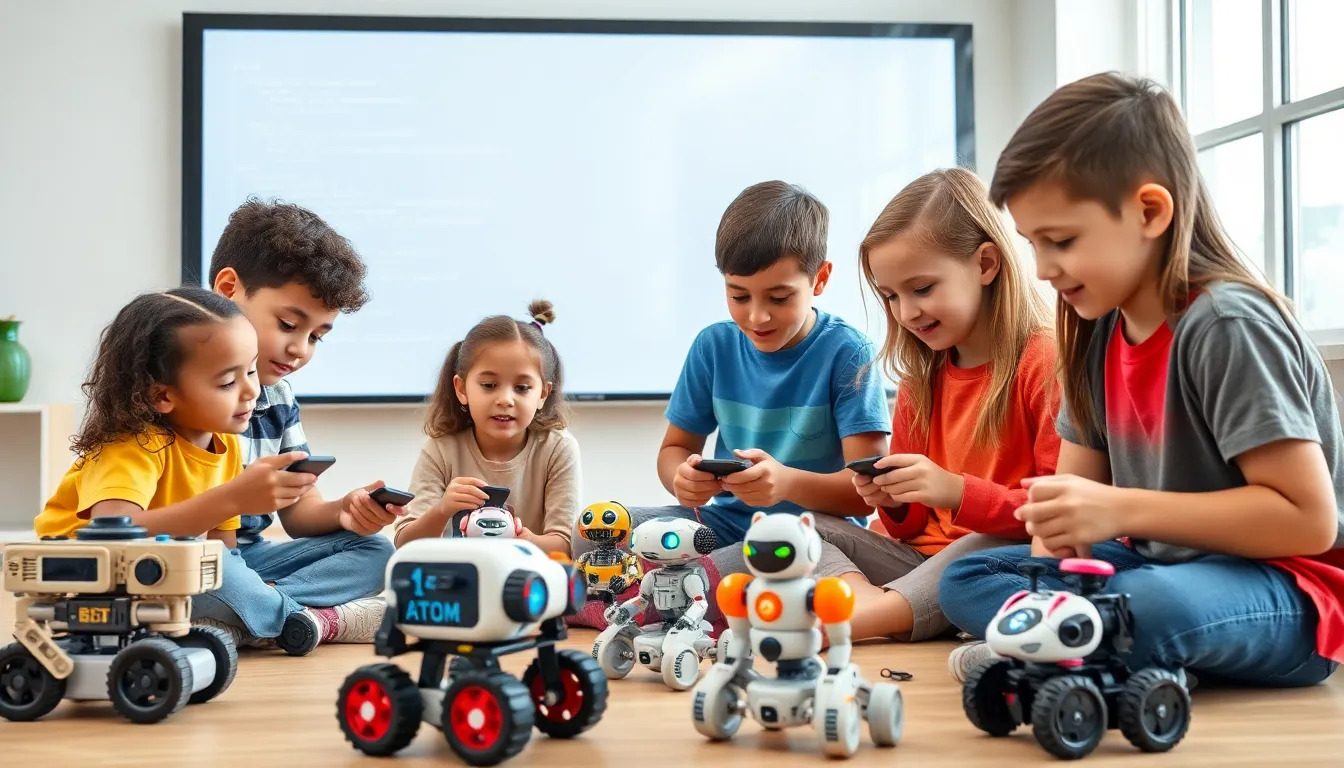Table of Contents
ToggleIn a world where playtime meets innovation, robotics toys are not just cool gadgets: they’re gateways to a future filled with creativity and learning. Imagine a toy that can dance, respond to commands, and even solve problems. Sounds a bit like something out of a sci-fi movie, right? But it’s not, it’s happening right now in countless family living rooms. From teaching kids coding to simply being a fun companion, robotics toys have taken playtime to a whole new level. So, buckle up as we jump into the intriguing realm of robotics toys and uncover why they might just be the best investment you make for your child this year.
What Are Robotics Toys?

Robotics toys are essentially playthings equipped with sensors, motors, and sometimes even artificial intelligence that allow them to interact with their environment. These toys can perform a range of functions, from simple movements to complex tasks like solving mazes or responding to voice commands. Think of them as a blend of traditional toys and high-tech gadgets. They often come with software to program behaviors, making them not just toys but mini-robots that your child can control and program.
In today’s tech-savvy world, where digital skills are critical, robotics toys offer an engaging way for kids to familiarize themselves with technology. They often lay the groundwork for understanding robotics, coding, engineering, and even problem-solving skills. Although they vary widely in complexity and price, at their core, robotics toys aim to inspire curiosity, promote learning, and provide entertainment.
Benefits of Robotics Toys for Children
The benefits of robotics toys are extensive and far-reaching. For starters, they help develop critical thinking skills. As children interact with these toys, they face challenges that require thoughtful solutions, enhancing their cognitive abilities. Besides, problem-solving becomes second nature as kids experiment with programming and troubleshooting.
Another notable advantage lies in their ability to promote teamwork and social skills. Many robotics toys encourage collaborative play, allowing children to work together to achieve a common goal. They learn the importance of communication and collaboration in the process.
And let’s not overlook how robotics toys can ignite a genuine interest in STEM (science, technology, engineering, and mathematics). By engaging with these toys, children are not just having fun: they’re also getting a head start in fields that will be crucial in their future. Overall, the educational benefits are a powerful reason to consider adding these gadgets to your child’s toy collection.
Types of Robotics Toys Available
When it comes to robotics toys, the variety is astonishing. They can be broadly categorized into a few types:
- Assembler Robots: These toys often come as kits where children build their robots from scratch. Kits like Lego Mindstorms or VEX Robotics provide all the components, allowing for an endless range of designs.
- Interactive Robots: Toys like Cozmo and Sphero are equipped with sensors and can engage with children through games and challenges. They also often have companion apps that enhance the gameplay.
- Coding Robots: Certain toys, such as Botley or Osmo, allow kids to learn coding through hands-on interaction. These toys often use a visual programming language that’s easy to understand, even for younger children.
- Educational Robotics: Toys like Dash and Dot focus on teaching kids basic programming concepts while they control the robots via a simple app.
- Remote-Controlled Robots: These classic toys offer a range of functionality, from racing to obstacle courses. Kids feel empowered as they take command.
How Robotics Toys Foster Learning and Creativity
Robotics toys are much more than just fun, there’s a deep educational layer that fosters creativity and learning. By programming these toys, children tap into their creative side. They visualize how their code translates into action, igniting their imagination in the process.
Also, robotics toys encourage experimentation. When a child programs a robot to perform a specific task, they get immediate feedback. If the robot doesn’t behave as expected, they learn to troubleshoot, iterate, and try again. This trial-and-error approach builds resilience and a growth mindset, crucial traits for tackling challenges in any field.
These toys also integrate various subjects beyond science. For instance, children might use their math skills to calculate angles for movement, or they can apply storytelling to create scenarios for their robotic characters, intertwining literacy and creativity with technology. The learning opportunities are vast.
Choosing the Right Robotics Toy for Your Child
Choosing the right robotics toy can feel overwhelming given the plethora of options available. First, consider your child’s interests and age. Younger kids might enjoy simpler, more interactive toys that offer immediate gratification, while older children might appreciate the challenge of building and programming their robots from scratch.
Next, think about the educational aspects. Prioritize toys that align with your educational goals, whether it’s sparking an interest in coding or fostering teamwork. Reading reviews and ratings can give insights into which toys provide the best educational value.
Also, don’t forget to factor in the level of support available. Some kits come with comprehensive guides and community forums, which can be incredibly helpful for both children and parents. You want a toy that will engage your child long-term, not just a one-hit wonder.
Popular Robotics Toys on the Market
Various robotics toys are currently trending and receiving rave reviews. Here are some of the most popular:
- LEGO Boost: This versatile kit combines traditional building with programming. Kids can build multiple models ranging from a robot to a cat with functionality.
- Sphero Mini: A small, app-controlled ball that teaches coding through games. Kids can navigate mazes or compete in challenges, making learning feel like play.
- Dash and Dot: These interactive robots are designed to foster basic coding skills. Children can program their movements and respond to commands, making for exciting gameplay.
- Botley 2.0: Known as an advanced coding robot, this toy doesn’t use screens, allowing kids to focus on tangible coding skills. It encourages logical thinking through physical challenges.
- VEX Robotics: A more advanced option, this kit is geared for serious young engineers interested in robotics and programming.
The Future of Robotics Toys
The future of robotics toys looks incredibly promising. As technology continues to evolve, expect to see even more advanced features integrated into these toys. Imagine robotics kits equipped with augmented reality capabilities, offering an immersive learning experience.
Besides, the development of artificial intelligence will likely make these toys even more interactive and adaptive to the user’s learning pace. Children will benefit from personalized experiences tailored specifically to their skill levels.
Finally, with growing emphasis on STEM education, robotics toys will become more mainstream, ensuring that kids worldwide have access to these valuable learning tools. This future undoubtedly holds a wealth of opportunities that combine learning with fun in ways we can only begin to imagine.







